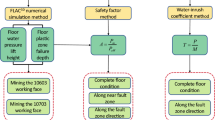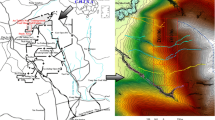Abstract
This study analyzed the failure characteristics of the coal seam floor induced by longwall mining to manage and eliminate possible hazards associated with high pressure (8.0 MPa) floor-confined water in the Xinjulong coal mine. The disturbed floor was divided into mining failure (MF), water-resistant (WR), and confined water intrusion (CWI) zones. The MF and CWI zones have lost their ability to resist the confined water, so the WR zone is the key for preventing water inrush from the floor aquifer. A thin-plate model for the WR zone indicated that the water pressure had to be decreased to 2.4 MPa or less. Multi-well pumping was used to decrease the floor aquifer water pressure from 8.0 to 2.1 MPa. Moreover, grouting was used to block water-conducting fractures in the floor strata. In addition, classification, purification, and recycling techniques enabled 84.8% utilization of the produced mine water.
Zusammenfassung
Die vorliegende Studie untersuchte die Charakteristika des durch Strebbau verursachten Versagens des Grundwassernichtleiters unterhalb eines Kohleflözes, um die mit dem unter hohem Druck (8,0 MPa) stehenden, gespannten Grundwasser im Xinjulong Kohlebergwerk einhergehenden potentiellen Gefahren bewältigen und beseitigen zu können. Der beeinträchtige Untergrund wurde in eine Versagenszone (mining failure: MF), eine wasserundurchlässige Zone (water-resistant: WR) und eine Wassereinbruchszone (confined water intrusion: CWI) aufgeteilt. Sowohl WR- als auch CWI-Zone haben ihre wasserstauende Eigenschaft eingebüßt, sodass die WR-Zone der Schlüssel zur Vermeidung von Wassereinbrüchen aus dem darunterliegenden Aquifer ist. Ein Thin-Plate Modell für die WR-Zone ergab, dass der Wasserdruck auf 2,4 MPa oder weniger hätte gesenkt werden müssen. Darüber hinaus wurde eine Verpressung der wasserführenden Klüfte in den Untergrundschichten angewandt. Zusätzlich ermöglichten Methoden zu Einstufung, Aufbereitung und Recycling die Verwendung von 84,8% des im Bergwerk anfallenden Wassers.
Resumen
Este estudio analizó las características de falla del piso de vetas de carbón inducidas por la extracción de muros largos para manejar y eliminar posibles riesgos asociados con el agua confinada en el piso a alta presión (8,0 MPa) en la mina de carbón Xinjulong. El piso perturbado se dividió en zonas de falla minera (MF), resistente al agua (WR) e intrusión de agua confinada (CWI). Las zonas MF y CWI han perdido su capacidad de resistir el agua confinada, por lo que la zona WR es la clave para evitar la irrupción de agua desde el acuífero del piso. Un modelo de placa delgada para la zona WR indicó que la presión del agua tenía que reducirse a 2,4 MPa o menos. El bombeo de pozos múltiples se usó para disminuir la presión del agua del acuífero del piso de 8,0 a 2,1 MPa. Además, la lechada se usó para bloquear las fracturas conductoras de agua en los estratos del piso. Además, las técnicas de clasificación, purificación y reciclaje permitieron la utilización del 84,8% del agua de mina producida.
大采深煤矿底板高压含水层水的管理与利用
为了治理和消除新巨龙煤矿底板含水层高压 (8.0 MPa) 威胁,分析了长壁开采引起的煤层底板破坏特征。受采矿扰动破坏的煤层底板被分为开采破坏带(MF)、阻水带 (WR) 和承压水导升带(CWI)。开采破坏带(MF)和承压导升带(CWI)已经失去阻隔承压水的能力,阻水带(WR)是防止底板含水层突水的关键。阻水带(WR)的薄板模型表明,底板含水层水压需被降至2.4 MPa以下。通过群孔抽水将含水层水压由8.0 MPa降至2.1 MPa;利用注浆技术封堵底板内导水裂隙。此外,矿井水分类、净化和再利用技术使矿井水利用率达84.8%















Similar content being viewed by others
References
Adams R, Younger PL (2010) A strategy for modeling ground water rebound in abandoned deep mine systems. Ground Water 39(2):249–261
Álvarez R, Ordóñez A, Miguel ED, Loredoa C (2016) Prediction of the flooding of a mining reservoir in NW Spain. J Environ Manage 184(Pt 2):219–228
Andrés C, Álvarez R, Ordóñez A (2016) Estimation of thermal conductivity of rocks from their mineralogical composition (Asturian Coal Basin, NW Spain) for modelling purposes. Environ Earth Sci 75(3):266
Blöcher MG, Zimmermann G, Moeck I, Brandt W, Hassanzadegan A, Magri F (2010) 3D numerical modeling of hydrothermal processes during the lifetime of a deep geothermal reservoir. Geofluids 10(3):406–421
Chen JT, Guo WJ, Yin LM, Lu C, Chang XK, Zhang SC, Zhang CX (2016) Experimental study of floor cracking under deep mining. Chin J Rock Mech Eng 35(11):2298–2306 (in Chinese)
Gan LT (2018) Prevention of limestone water in coal floor of group a of huainan mining area and causes analysis of water inrush accidents in pan’er mine. Saf Coal Mines 49(7):171–175 (in Chinese)
Gandy CJ, Younger PL (2007) Predicting groundwater rebound in the South Yorkshire Coalfield, UK. Miner Water Environ 26(2):70–78
Guo WJ, Zhang SC, Sun WB, Chen JT (2018) Experimental and analysis research on water inrush catastrophe mode from coal seam floor in deep mining. J Chin Coal Soc 43(1):219–227 (in Chinese)
Halford KJ, Weight WD, Schreiber RP (2006) Interpretation of transmissivity estimates from single-well pumping aquifer tests. Ground Water 44(3):467
Hamm V, Sabet BB (2010) Modelling of fluid flow and heat transfer to assess the geothermal potential of a flooded coal mine in Lorraine, France. Geothermics 39:177–186
Hartl RF, Kirakossian GT, Hakobyan SR, Markaryan AH (2006) A dynamical model of water recycling in a mine-processing enterprise. Cent Eur J Oper Res 14(1):45–57
Hou JL, Xie GX, Tang YZ, Li JB, Huang X, Zhang JB, Wang MH (2013) Three-dimensional mechanical characteristics of rocks surrounding the stope of thick unconsolidated layers and thin bedrock. J Chin Coal Soc 38(12):2113–2118 (in Chinese)
Hu WY (2010) The characteristics of karst and deep coal mine karst water hazards in eastern North China. Coal Geo Explo 38(2):23–27 (in Chinese)
Hu WY, Yin SX (2010) Dynamic mechanism of water inrush from floor of mining face. Chinese J Rock Mech Eng 29:3344–3349 (in Chinese)
Kang YS, Liu QS, Gong GQ, Wang HC (2014) Application of a combined support system to the weak floor reinforcement in deep underground coal mine. Int J Rock Mech Min 71:143–150
Kranz K, Dillenardt J (2009) Mine water utilization for geothermal purposes in Freiberg, Germany: determination of hydrogeological and thermophysical rock parameters. Mine Water Environ 29:68–76
Li BY (1999) “Down Three Zones” in the prediction of the water inrush from coalbed floor aquifer theory, development and application. J Shandong Inst Min Tech 18(4):11–18 (in Chinese)
Li H, Bai HB, Wu JJ, Wang CS, Ma ZG, Du YB, Ma K (2017) Mechanism of water inrush driven by grouting and control measures—a case study of Chensilou mine, China. Arab J Geosci 10(21):468
Liu WT, Liu SL, Song WC, Zhang MP, Xie XX, Dr Mu (2015) Study on stability of mining face floor aquiclude based on Thin Plate Theory. Coal Sci Tech 43(9):144–148 (in Chinese)
Ma YJ, Feng Y, Zhang ZY, Yi SX (2014) Analysis and application on the advanced discharge of water-rich aquifer of coal floor. J Chin Coal Soc 39(4):731–735 (in Chinese)
Ma LQ, Jin ZY, Liang JM, Sun H, Zhang DS, Li P (2015) Simulation of water resource loss in short-distance coal seams disturbed by repeated mining. Environ Earth Sci 74(7):5653–5662
Odintsev VN, Miletenko NA (2015) Water inrush in mines as a consequence of spontaneous hydrofracture. J Min Sci 51(3):423–434
Rapantova N, Grmela A, Vojtek D, Halir J, Michalek B (2007) Ground water flow modelling application in mining hydrology. Mine Water Environ 26(4):264–270
Shen RX, Qiu LM, Li BL, Kong B, Niu Y (2015) “Three fields” evolution of water inrush process under high confined water in stope floor. J Min Saf Eng 32(2):213–218 (in Chinese)
Shi LQ, Xin HQ, Zhai PH, Li SC, Liu TB, Yan Y, Wei WX (2012) Calculating the height of water flowing fracture zone in deep mining. J Chin U Min Tech 41(1):37–41 (in Chinese)
Shimada H, Hamanaka A, Sasaoka T (2014) Behaviour of grouting material used for floor reinforcement in underground mines. Int J Sur Min Recl Environ 28(2):133–148
Singh AP (2013) Prediction of sea water intrusion for mining activity in close precincts of sea shore. Springerplus 2(1):1–10
Sun J, Wang LG, Hou HQ (2013) Research on water-isolating capacity of the compound water-resisting key strata in coal seam floor. J Chin U Min Tech 42(4):560–566 (in Chinese)
Wang DP (2016) Research on mechanism of mining-induced hidden karst subsidence column water inrush and seepage coupling model. Coal Eng 48(7):93–96 (in Chinese)
Wang W, Chen P, Zheng QQ, Zheng XY, Lu KM (2013) A modified calculation model for groundwater flowing to horizontal seepage wells. J Earth Syst Sci 122(2):407–418 (in Chinese)
Wolkersdorfer C, Bowell R (2004) Contemporary reviews of mine water studies in europe. Mine Water Environ 23(4):161
Wu J (2014) Progressproblems and prospects of prevention and control technology of mine water and reutilization in China. J Chin Coal Soc 39(5):795–805 (in Chinese)
Wu Q, Liu YZ, Liu DH, Zhou WF (2011) Prediction of floor water inrush: the application of gis-based ahp vulnerable index method to Donghuantuo Coal Mine. China. Rock Mech Rock Eng 44(5):591
Xie HP, Hou ZM, Gao F, Zhou L, Gao YN (2015) A new technology of pumped-storage power in underground coal mine: principles, present situation and future. J Chin Coal Soc 40(5):965–972 (in Chinese)
Xu YC, Li JB (2014) “Pore-fractured lifting type” mechanical model for floor water inrush of the grouting enforcement working face. J Chin U Min Tech 43(1):49–55 (in Chinese)
Xu GQ, Yan JP, Xia XL (2010) Optimization experiment on mixing ratio of new grouting material to prevent mine floor water inrush. Coal Sci Tech 38(12):22–24 (in Chinese)
Xu PY, Cao W, Wang LF, Zhang XA (2016) Construction technology of rapid drilling for emergency rescue in zhongcun coal mine. Explo Eng (Rock Soil Dril Tun) 43(10):278–280
Xu GS, Zhang YB, Li DH, Hou DF, Yu HZ, Tan Y, Feng JF (2018) Mechanics model and its application of movement and deformation of main roof considering abutment pressure. J Min Saf Eng 35(2):339–346 (in Chinese)
Yin HY, Wei JC, Lefticariu L, Guo JB, Xie DL, Li ZL, Zhao P (2016) Numerical simulation of water flow from the coal seam floor in a deep longwall mine in China. Miner Water Environ 35:243–252
Yu XG, Han J, Shi LQ, Wang Y, Zhao YP (2017) Application of a BP neural network in predicting destroyed floor depth caused by underground pressure. Environ Earth Sci 76(15):535
Zhang W, Huang GH, Zhan HB (2008) Non-Darcian flow to a well in an aquifer–aquitard system. Adv Water Resour 31(12):1754–1763
Zhang X, Li SC, Zhang QS, Li HY, Wu WD, Liu RT, Lin MY (2010) Filed test of comprehensive treatment method for high pressure dynamic grouting. J Chin Coal Soc 35(8):1314–1318 (in Chinese)
Zhang X, Gao L, Barrett D, Chen Y (2014) Evaluating water management practice for sustainable mining. Water 6(2):414–433
Zhao QB, Bi C, Hu WY, Wang HQ, Nan SH, Liu ZB, Chuai XY (2016) Study and application of three-stage seriflux diffusion mechanism in the fissure of aquifer with horizontal injection hole. J Chin Coal Soc 41(5):1212–1218 (in Chinese)
Zhu SY, Jiang ZQ, Zhou KJ, Peng GP, Yang CW (2014) The characteristics of deformation and failure of coal seam floor due to mining in Xinmi coal field in China. B Eng Geo Environ 73:1151–1163
Acknowledgements
This work was supported by the Fundamental Research Funds for the Central Universities (2017XKQY096) and the Priority Academic Program Development of Jiangsu Higher Education Institutions.
Author information
Authors and Affiliations
Corresponding author
Electronic supplementary material
Below is the link to the electronic supplementary material.
Table S-1
Rock physical and mechanical parameters
Fig. S-1
Procedure of Rayleigh–Ritz method
Fig. S-2
Distribution of maximum principal stress across E1-E1 and E2- E2 sections. E1-E1 section (a); E2- E2 section (b)
Fig. S-3
Failure scheme of WR zone
Fig. S-4
Schematic of multi-well pumping
Fig. S-5
Deformation of the WR zone
Fig. S-6
Broken characteristics of the WR zone. Fractures formed on the long side of bottom surface (a); Fractures formed on the top surface (b); Fractures formed on the short side of bottom surface (c); Fractures connected of the bottom and top surface (d)
Rights and permissions
About this article
Cite this article
Guo, J., Ma, L. & Zhang, D. Management and Utilization of High-Pressure Floor-Confined Water in Deep Coal Mines. Mine Water Environ 38, 780–797 (2019). https://doi.org/10.1007/s10230-019-00639-9
Received:
Accepted:
Published:
Issue Date:
DOI: https://doi.org/10.1007/s10230-019-00639-9




